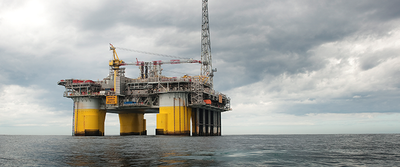Urgent Need to Cut Costs in UK North Sea
Britain's North Sea oil and gas industry faces a bleak future where more fields are likely to become uneconomic and shut in as platforms close - unless costs can be controlled, operators say.
For some elderly platforms in the Northern North Sea, time is running out. If the industry does not get to grips with costs quickly, fresh investment is likely to dry up, forcing unsaleable rusting rigs to be abandoned.
"From a cost point of view, the chickens are coming home to roost," said Tim Walsh, senior vice president, asset integrity services at Lloyd's Register Energy. "If we don't see reductions in cost then there is a danger operators would face even greater challenges in maintaining asset integrity."
Some of these spiralling costs are driven by age. As production declines, fixed costs must be supported by smaller revenue streams, and with older platforms deteriorating, maintenance costs are building. Other cost increases have been laid at the door of services companies and input prices.
"As a harsh offshore area, the North Sea has always been intrinsically expensive, but that's now being exacerbated by the age of some of the facilities and the associated amount of downtime that's emerging," said Philip Whittaker at the Boston Consulting Group (BCG).
"In 2008 there were excessive margins in the system to squeeze the service providers, but now there isn't. So they have to look for a different way of doing business."
The industry hopes to force costs down by improving production efficiency, tackling supply chain problems and improving collaboration and infrastructure access.
Trade body Oil & Gas UK's Activity Survey put average unit operating costs (UOC) at 17 pounds ($28.85) per barrel in 2013 but the number of fields with a UOC greater than 30 pounds per barrel doubled in the previous 12 months.
In 2013, the cost of operations in the UK Continental Shelf (UKCS) rose by 15.5 pct to 8.9 billion pounds. For 2014 it sees costs rising further to around 9.6 billion pounds.
"This is becoming unsustainable - costs are getting to a level in the UK where they are making some developments uneconomic," said Amjad Bseisu, chief executive of EnQuest, the largest UK independent producer in the UKCS.
Shelving Projects
Shelving a new project is one option for cost-conscious majors, like Chevron's Rosebank and Statoil's Bressay, which have the option of investing elsewhere.
"The North Sea is undoubtedly moving up the supply cost curve and oil companies may take the view that there are better places to spend their money, unless fiscal terms adapt to stay globally competitive," said BCG's Whittaker.
Existing facilities with high operating costs present different challenges.
Speaking at Oil & Gas UK's conference in Aberdeen last week, John Pearson, group president, Europe at oilfield services company AMEC, said the average barrel produced in the UKCS, with gas included, is now worth around $60 a barrel, and many of the mature field lifting costs are very close to that.
"The slow decline of production just makes that worse," he said. "We've all made many cuts, but these were either less of the same thing, or the same thing for less. Neither of those is completely sustainable - it's not a structural change in our cost base."
Andrew McCallum, director of corporate affairs and business support at Dana Petroleum, agreed: "At the current oil price level certain developments and activities are economic but even if there is just a small decrease in the oil price, that changes pretty dramatically. We're now in an environment where a fluctuation of just $10-$15 could have quite a profound effect."
He said the industry needed to pay closer attention to how supply chains function: "More can be done to co-ordinate supply vessels and the way that materials come to the infrastructure."
Desperate for solutions, the industry has set up a working group of operators and contractors to look at ways of driving costs down. The aim is to get the sector to work more collaboratively and efficiently, to improve economies of scale.
"The real savings span the interfaces between the links in the supply chain," said AMEC's Pearson. Standardisation also offered a "huge seam of cost efficiency and predictability," he said.
Non-standardisation contributes to poor production efficiency as suppliers may struggle to meet different customer demands and technical specifications of ageing facilities, BCG's Whittaker said.
"For example, on old sub-sea wells, installation tools may no longer be available or specifications may even have been lost. These technical bottlenecks generate inefficiencies such as costly one-off replacement orders," he said.
($1 = 0.5893 British Pounds)
(By Claire Milhench, Editing by William Hardy)











